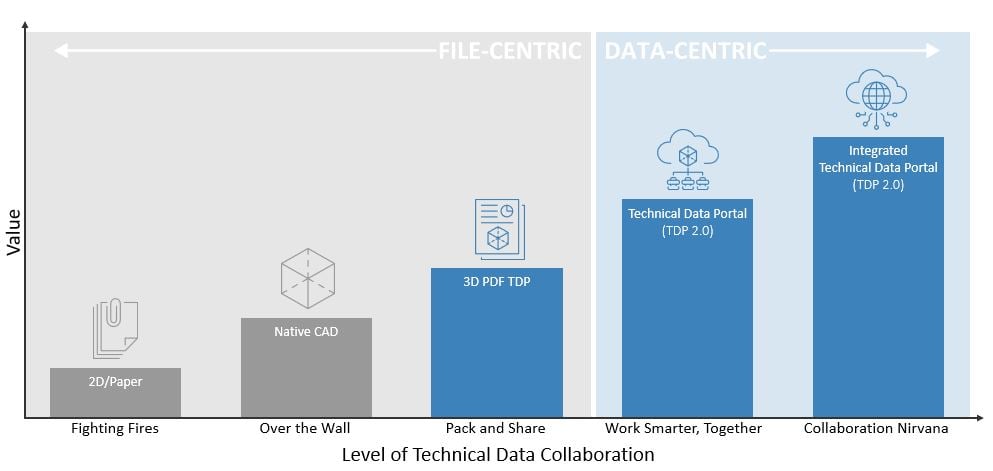The Technical Data Collaboration Maturity Model shows the progression from file-centric to data-centric collaboration, and the business and people benefits that accrue as you move from technical data packages through each stage. The stages are outlined below:

Stage 1: Fighting Fires
The first stage is categorized by the historic use of paper drawings as well as digital two-dimensional drawings that require interpretation by your supply chain. The days of mailing drawings are behind you, but the use of email is still rampant, and SharePoint becomes a file dumping ground. Version control is cumbersome and difficult. In stage 1, communication is verbal or through disconnected email threads.
Stage 2: Throw it Over the Wall
In stage 2 companies begin to put some guardrails around data sharing and provide product data in the form of native CAD. Email is still commonly used to communicate and companies are using services like SharePoint or Box for file sharing. While 3D geometry helps with understanding, sharing native geometry requires the use of complex software and a distinct skill set. Additionally, the data is outdated the moment it is downloaded. Security is a concern as files can be changed (accidentally or intentionally) with ease.
Stage 3: Pack it Up and Share
Many companies go through a period where they tried to use the tools provided by their CAD vendor to communicate with the supply chain. While these free tools seems promising, eventually limitations are revealed.
Bill of materials data and CAD hierarchies are combined with metadata that largely exists in PLM or PDM systems. This means supplier communication comes from various sources. This has led to the evolution and adoption of CAD-agnostic technical data package using 3D PDF.
While there has been significant productivity gains using a standard such as PDF, stage 3 still has problems that stem from the fact that 3D PDFs are still just files. When downloaded they can be shared indiscriminately, and security is a concern. These files can be rather large, and they can take a long time to open and interact with as well as being prohibitive to transfer. Version control is still cumbersome and limited.
Stage 4: Work Smarter, Together
Stage four is where customers move from a file-centric mentality to a data-centric mentality.
The technical data package, once a file, becomes a technical data portal. Data is streaming, in real time, on any device and there is no question of applicability. Security is robust, with time limits for viewing data and dynamic watermarking to ensure that screen captures are stamped with information such as user and time. The Technical Data Portal is typically linked to the authoritative source of product data, such as PLM, and the publishing is automated reducing the potential for user error. There is a focus on proper dissemination and embedded visualization. Suppliers are served with the right files and documents instead of having to download them.
A major advantage of stage four is contextual collaboration inside of the technical data portal. Suppliers can ask questions around an item, that question is passed to the product owner to answer, and the entire interaction is captured inside of the system for future reference.
Stage 5: Collaboration Nirvana
The final stage is defined by advancing industry trends towards closer supplier partnerships and product co-development. Information, including files, are shared bidirectionally within the context of the technical data portal framework where discussions are captured and available to OEMs and suppliers.
By adopting a Technical Data communication platform, companies are able to take advantage of emerging upgrades to the ecosystem. This next evolution of the next generation Technical Data Portal will be focused on continuous improvement through analysis of ongoing supplier communications and advances in social collaboration tools.
The Maturity Model outlines a linear progression from one stage to the next, but your own progression through the different stages of the model can be as unique as your design and sourcing environment. Our latest eBook expands upon this maturity model and more for you.
Use it pinpoint where you are when it comes to data sharing and collaboration in your supply chain, and visualize what progression through each of the five maturity stages looks like.
If you’re able to chart a path to supply chain nirvana now, you have a greater chance of being among the few manufacturers who are able to quickly make good on their intention to build high-value, highly-collaborative supplier partnerships this year.


